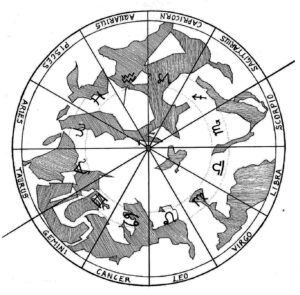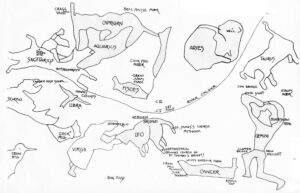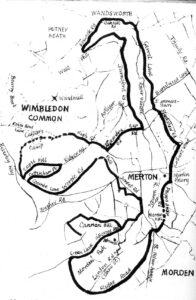A few weeks ago, the subject of terrestrial zodiacs popped up in discussions on our e-group, NEReaders. They are definitely a carry-over from our early earth mysteries days, when questions previously deemed beyond credibility were to be asked and reconsidered (like leys), possibilities explored, and new hypotheses of the past and subtle reality to be investigated (and accepted or rejected except where the eye of faith and the blinkers of belief intervened). Things like leys, archaeo-astronomy and trance-induction sites made it through, with some modification − this is after all how knowledge progresses. Earth mysteries itself didn’t really make it through, as it separated into its own empiricism vs belief dichotomy, and the e.m. tag came to be more associated with its more subjective wing.
NE belongs on the left-hand path of that dichotomy, and holds that hypotheses need to be if not necessarily objectively demonstrable, then at least candidates for discussion at some level of scientific enquiry, even if just its farther shores. So nowadays NE, like earlier magazines like 3rd Stone, prefers to use neo-antiquarian as a descriptor rather than earth mysteries; nonetheless, we still share the same umbrella as more populist, mystical and it must be said often more beguiling belief-led perspectives. In this, our field still holds true to those early principles of enquiry that fired us in the 1960-70s, that even notions once rejected are fair game for constant reappraisal – as long as new evidence or perspectives appear to shed new light. Attempting to reinvent the wheel on the lines of a 50p coin is not an option. Holding on to notions that have shown themselves on enquiry to be unsupported is religious belief, not understanding; and in these days where the Old Testament appears to be making a comeback we know where that gets us.
Anyway, back to landscape zodiacs. If anything were to be ripe for a lunatic fringe consignment, it’s surely them, and indeed even in earth mysteries circles, after a vigorous rebirth in the 1970s, they soon faded away as people found them less and less amenable to intellectual defence, at least in the parameters of our time. Recently, they’ve mostly appeared in New Age circles, and with little attempt to establish any argument for them except assertion.
To reprise the basic premise; a landscape zodiac is an entity which is usually ‘discovered’ on a map, and consists of shapes made by features on that map which equate to the signs of the zodiac in their correct order. As such it is a material 2-D representation, and at this stage is at best a kind of artwork conjured up by the visual format of the map, which is itself according to a survey drawn up at a particular time and reproduced to production and representation preferences of that time. The first to be claimed was the Glastonbury Zodiac, by Katherine Maltwood in the 1920s.1 By the end of the 1970s, over 60 had been posited.2 Oddly, they overwhelmingly fell into representations different in some cases from the popularly familiar zodiac, such as a bird replacing the scales of Libra or a boat standing in for the crab of Cancer.
Few of those 60+ were ever heard of again, but some, particularly the Glastonbury Zodiac, have proved remarkably resilient. The obvious question, ‘Are the patterns on the map actually discernible to observers in the landscape?’, is sometimes visually affirmed, and even more so if the lens is broadened to include toponyms and folklore − but this kind of affirmation is obviously too easily circumstantial. So are they Rorschach-type images gleaned from the mass of information presented on a typical Ordnance Survey map? Certainly the imagination sees patterns, and certainly without the faculty of imagination one is unlikely to see such images, so a picture of a bull, say, is well within the possibility of chance, as is the face of Jesus − but if the symbols of the four apostles turn up along with Jesus (which thankfully they haven’t yet, to my knowledge) then the statistical likelihood of chance is substantially reduced. So when a dozen recognisable zodiac symbols appear in an appropriate progression, we are surely entitled to ask ‘what is going on here?3

Maltwood’s Glastonbury Zodiac
And anyway, how could they happen? ‘Ancient mysteries’ was often the go-to explanation in the 1970s − massive terraforming by sages from the old undocumented days of history, or, if that was too much to swallow for some, by extra-terrestrial or divine forces. And what’s their point? Either creation story comes across as an extremely unproductive exercise − unless they are, as Maltwood and others have claimed (in some desperation, I suspect), representations of the heavenly configurations on earth, i.e. as above so below. We are still entitled to ask ‘so what?’
As with religion, pettifogging questions still keep cropping up. Most damaging to the ancient mysteries hypothesis is obviously that things like trackways and human settlements and naming, which feature so much in the terrestrial zodiac paradigm, are not only historical entities but have also been subject to much change in recent centuries. We could go on with such eminently reasonable and irrefutable objections, and even as I type this I find myself wondering why I’m even bothering to write this article. And it’s because I find myself, a confirmed follower of the empiricist wing, wondering ‘Is this all there is to these things?’
I probably wouldn’t bother if I didn’t have skin in the game, as the expression goes. Because one of those 60+ came from my own pen. Not entirely willingly, I should point out; exasperated by some of the 1970s claims, I recalled how back then on the way home from a hillside pub one night a friend and I had noted how we could see the figure of Sagittarius drawn in the streetlights of Mytholmroyd. So I sat down with an OS map and tried to draw and trace it; yes, there it was, I chortled, and went to bed with plans for a spoof gambolling in my head. I awoke that night from a dream of a massive scorpion curving around a hillside. Out came the maps and tracing paper again… Over the next few days, with greater or lesser accuracy, I had a set of zodiac figures matching the now-familiar British template, arcing around the then little-known hub of alternative experience, Hebden Bridge. It could still be a spoof, or a figment of imagination, but anyway it seemed a bit of fun and gave me a reason to get out into the Calder valley hills and do a little bit of outré local history.

What I found there were repeated instances of curiosity and coincidence that aligned, or seemed to align, with the various signs − surely a certain amount of confirmation bias, but it was enough to lead a sequence of guided walks around the zodiac at the appropriate seasons, when confirmation bias, if that was what it was, kicked in some more − walkers, especially those who came throughout the year, told me they felt the zodiac had some kind of demonstrable existence, but still felt the same logical objections. Features which enhanced the zodiac were often datable to some extent, and varied widely − clearly no planning was involved, and the signs evolved in a happenstance fashion, being apparently drawn out by local inhabitants piecemeal over centuries, without any directed input. Things were getting curiouser and curiouser. I had a choice − drop it or follow it down the rabbithole. I know from other areas of neo-antiquarian and e.m. study, as well as personal experience, that lived realities are not as cut-and-dried materialist as some rationalists would have us think, so I chose the latter. If nothing else, trying to demonstrate a possible rationale for something that challenged it at every turn was a mental exercise to counter any intellectual complacency that might grow with age.
So of course there were questions like ‘Can these things be found anywhere?’ In my opinion, no – they are dependent on a lot of human settlement in, and adaptation of, place. Another question I asked was ‘Did they exist before they were posited?’, and perhaps counter-intuitively I came to think that, despite the map ‘evidence’, perhaps not; but was a linear idea of time the right approach? ‘Do they have an independent existence?’ − well, you may have to tweak your parameters a bit, but yes, I think the few better researched examples may well pass that test.
I am an apologist for terrestrial zodiacs rather than an advocate, and I’d be hard pressed to maintain any existence for them outside Imagination (capitalised in the Blakean sense). However, I feel that like leys and other contested concepts, they have a place within the history of ideas; and that a way by which they might be apprehended is through an appreciation of agency between people and place. The inroads, to my mind, were offered by art, phenomenology, psychogeography and hauntology, backed up by certain controversial implications of quantum physics that potentially enable the identification of a creation point. The problem was how to synthesise these, and, in a way, to make these damned things work for us, to offer them a role and a working reality within the ways we relate to place.4
Because there’s another end to this telescope. The terrestrial zodiac is a hauntological entity, its temporal disjunction characterised in the multi-periodicity of the formative elements encountered in each sign; from one perspective, addressed in my working paper*, it may be the future haunting the present by masquerading as the past. Rather than waiting for a lost time to emerge from the landscape, one can project lost dreamtimes upon a place, to render that place inhabited anew as if by ancient narratives, as an opening gambit in a conversation, or as a lens that can penetrate a veil. We are perhaps too infected by mundanity today to make our own myths that will appeal across our cultures, between generations, but we can borrow other narratives as a magical scrying mirror, and access them through our local place − after all, Mary Caine managed it in Kingston-upon-Thames, and transformed its suburban streets. The terrestrial zodiac can be celebrated for its potential as a tool for dissolving perceptual boundaries.

Scorpio in the Kingston Zodiac (Mary Caine)
First, though, we need a method to reclaim these zodiacs as experience, and what I suggest is that we walk our myths into place: that we use local history and our own perception together with vignettes adapted from past cosmologies, legends and astrological understandings, in an attempt to understand place, how people interact with place, and even the nature of time in a place. The psychopomp god Hermes might not be familiar with, say, Hebden Bridge, but that’s no reason why he might not be our guide.
With the terrestrial zodiac, although one walks with an OS map, one is also equipped with personal intimacy and openness, hopefully some knowledge of otherworldly narratives and local history, and the ability to relate them to the place where one walks. And one can invoke the appropriate genii and mythical and legendary events to replay in the imaginal landscape behind the real scene. And, oddly, one might find that features of the world one walks through resonate, historically and presently, with the mythic imagination.
Exploration of a landscape through the different eyes and pathways afforded by unfamiliar mythologies and concepts may take on the nature of a quest – a quasi-shamanic journey in territory rendered less familiar by taking a route through the ancestral underworld of our minds. And like any good psychogeography, like any good otherworld journey, one might bring back something that will be of benefit to the world, that may bring a new ray of illumination.
Because if not, what is the point?
* My working paper on a new approach to landscape zodiacs makes for a longish story, too long and layered for the pages and timing of this little magazine − but if anyone is interested, then the complete multi-part article is available now on our website:
https://northernearth.co.uk/walking-myth-into-place-the-damned-zodiac/
Published in NE174 (Dec. 2023), pp20-23
https://northernearth.co.uk/subscription/
Notes
- K E Maltwood, A Guide to Glastonbury’s Temple of the Stars (first pub. 1929)
- Philip Heselton, Earth Mysteries, Element 1995, p72
- Though Ulrich Magin claimed to have found one matching the t.z. parameters in 30 minutes around a village in Germany. ‘A Zodiac Experiment’. The Ley Hunter 127, 1997, p6.
- I’m not the only one to have chased this elusive beast, and I was pleased to find that, working independently, Anthony Thorley has found some very similar routes through the thickets, while other writers, such as Mary Caine, have also explored similar ways to draw these things into our consciousness, often drawing on myth and legend. Could these fingers be pointing out a route by which terrestrial zodiacs can be rescued from eternal damnation? See Anthony Thorley, ‘Contemplating Zodiacal Dreamtime’, in Yuri Leitch (ed.), Signs and Secrets of the Glastonbury Zodiac, Avalonian Aeon 2013, p309-327; Mary Caine, The Glastonbury Zodiac, Grael Communications 1978, The Kingston Zodiac, priv, n.d (c1981)